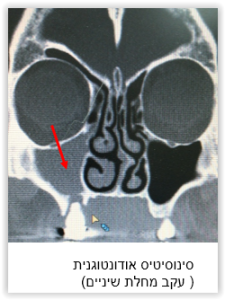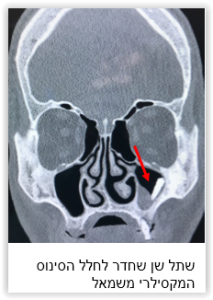Sinusitis is usually described as a kind of complication that follows an acute cold. You would certainly be surprised to hear that one can contract sinusitis that originates from dental disease. In professional jargon, this disease is known as odontogenic sinusitis.
What do the sinuses have to do with the teeth?
The eruption area of the posterior teeth (molars) in the upper jaw is very close to the floor of the sinus, or as it is called professionally, the maxillary sinus. The maxillary sinus is the largest sinus of the skull and its floor is flush with the tooth roots and the bone crest from which teeth grow into the oral cavity. This proximity results in a connection between diseases of the teeth and those of the maxillary sinus.

What are the causes of odontogenic sinusitis?
Odontogenic sinusitis is a common disease. One in ten cases of sinusitis is odontogenic.
Odontogenic sinusitis used to originate from poor oral hygiene. Today, with an increase in the frequency of surgical procedures in the oral cavity and the technological breakthrough in dental prosthetics, the most common cause of the disease is side effects after tooth extractions or prostheses on implants.
Dental implant placement for restoring the dentition and improving quality of life is very common and is performed by dentists or oral and maxillofacial surgeons. Bone resorption in the alveolar (tooth) ridge prevents good implant retention and requires augmentation of the bone tissue. In the mid-1970s, an American dentist called Dr. Tatum demonstrated a surgical approach in which a pocket was formed in the mucosa lining the maxillary sinus cavity. Bone material or bone substitute is introduced into this pocket, which then attaches to the original bone, augmenting the alveolar ridge. This approach is routinely called a “sinus lift”.

Following procedures such as a sinus lift or extraction of teeth and in certain cases due to chronic tooth root disease, infection may pass from the oral cavity into the maxillary sinus cavity, including development of inflammation known as odontogenic sinusitis.
How does odontogenic sinusitis manifest?
The most common complaint of sinusitis that originates from teeth may be acute pain in the back teeth, or a feeling of malodorous, thick snot from the nose on the diseased size.


How should the odontogenic sinusitis treatment or investigation be managed?
The most important thing is cooperation between the ENT specialist and dentist. In the absence of such cooperation, the treatment by each of these practitioners may take longer than desirable. In such cases, the patient juggled between the ENT specialist and dentist in repeat treatment sessions and appointments, including surgical ones, until the dentition may be restored. This process sometimes takes months or longer, with a long recovery time between them.
The classic case of excessive “procrastination” is contending with patients suffering from severe rhinosinusitis such as rhinosinusitis with polyps. This condition requires dental prostheses with a sinus lift. When the patient suffers from chronic rhinosinusitis, the risk of secondary infection that endangers the patient and reduces the chances of success of the entire implantation increases.
המקרה הקלאסי של “סחבת” ממושכת, היא ההתמודדות עם מטופלים הסובלים מרינוסינוסיטיס קשה כדוגמת רינוסינוסיטיס עם פוליפים. מצב זה דורש שיקום שיניים עם הרמת סינוס. כאשר המטופל סובל ממחלת רינוסינוסיטיס כרונית, עולה הסיכון לזיהום משני, שמסכן את המטופל ומקטין את סיכויי הצלחת ההשתלה כולה.
Cooperation between the ENT specialist and the dentist allows for:
- Holistic assessment and treatment of chronic sinusitis originating from a tooth infection.
- Consolidated treatment of dental treatment complications, such as: a sinus tract (fistula) between the oral cavity and sinus after extraction of a tooth or a dental implant penetrating the sinus cavity.
- Consultation for dentists in the case of a finding in the sinuses before sinus lifting.
- Dentists consulting ENT specialists in cases of findings attendant to chronic sinus disease that appear in imaging (cysts, impacted teeth, etc.).
What does the ENT specialist examine?
A patient who is referred to a clinic at the recommendation of the dentist will have a comprehensive clinical history taken and an examination performed, including endoscopic imaging of the nasal cavity and the area of the openings of the sinuses, and a careful inspection of the oral cavity and teeth, while considering existing medical information (including images).
In conclusion: a preliminary evaluation of the patient with a finding in a sinus cavity, as demonstrated in the dental x-ray by an ENT specialist, is a preventive action that may reduce the risk when performing a sinus lift and improves the chance of success in the procedure.
Cooperation between the ENT specialist and dentist in cases such as a complication after a surgical procedure allows for coordinated, simultaneous care, reduces the recovery time and the attendant suffering and will significant reduce the time for investigation and treatment before subsequently making prosthetic dental restorations.
Cooperation between the ENT specialist and the dentist can include joint assessment, joint treatment (including surgical treatment) and joint follow up until recovery.
Joint surgical treatment will last just 3 hours. The patient will be discharged home after a brief, one day hospital stay.
It is important to note that at the end of each treatment, the patient is referred back to the dentist making the dental prostheses in order for him to complete his prosthetic work.